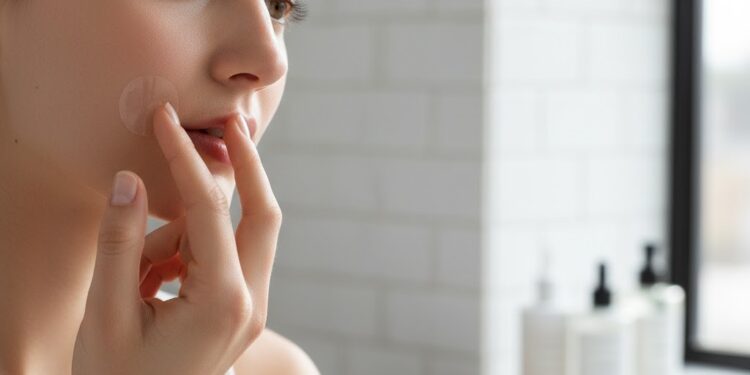What Are Pimple Patches?
Pimple patches, often called acne stickers, are small, clear adhesive dots that you place directly on pimples. They’re designed to absorb fluid, protect your skin from bacteria, and promote faster healing.
These patches are made from a material called hydrocolloid, which has been used in medical wound care for years. It’s a moisture-retentive dressing that draws out pus and oil from open wounds or pimples, helping them heal cleanly without scarring.
Table of Contents
How Do Pimple Patches Work?
Pimple patches work by creating a clean, moist environment that absorbs impurities while protecting the area from dirt, bacteria, and picking.
When you apply one, the hydrocolloid layer starts absorbing pus, oil, and debris from the pimple. As it does, it forms a white or cloudy spot on the patch — that’s the fluid it’s pulled out.
At the same time, the patch seals the area to:
- Prevent you from touching or squeezing the pimple
- Stop bacteria from entering
- Maintain moisture, which speeds up healing and reduces redness
Hydrocolloid patches don’t “pop” pimples; they help the skin heal naturally by pulling out excess fluid and reducing inflammation.
The Science Behind Hydrocolloid
Hydrocolloid technology isn’t new. It’s been used in hospitals for wound healing because it creates the perfect balance of moisture and protection. When applied to acne, it works similarly:
- Absorbs exudate (pus, oil, and fluid)
- Prevents scabbing by keeping the area hydrated
- Encourages new cell growth for smoother healing
That’s why dermatologists often recommend hydrocolloid-based patches for small whiteheads, post-popped pimples, or healing acne spots.
Types of Pimple Patches
Not all pimple patches are the same. Depending on your skin needs, you can choose from:
1. Hydrocolloid Patches
Best for whiteheads or healing pimples. They draw out fluid and reduce swelling.
2. Medicated Patches
Contain acne-fighting ingredients like:
- Salicylic acid – unclogs pores
- Tea tree oil – kills acne-causing bacteria
- Niacinamide – calms redness and inflammation
3. Microneedle Patches
These have tiny dissolving needles that deliver ingredients deeper into the skin, ideal for early or cystic pimples.
How to Use a Pimple Patch Correctly
- Cleanse your face and dry the area completely.
- Apply the patch directly on the pimple.
- Leave it on for at least 6–8 hours or overnight.
- Remove gently once it turns white or cloudy.
- Follow with your regular skincare routine.
Avoid applying moisturizer or serums before the patch — oils can prevent it from sticking and working effectively.
What to Expect After Removing a Pimple Patch
When you peel it off, you might see a white spot on the patch. That’s the pus and oil it absorbed. Your pimple will likely appear flatter, less red, and cleaner.
If the spot is still open or slightly raw, avoid touching it. You can apply a gentle soothing product like aloe vera or a light moisturizer.
Do Pimple Patches Really Work?
Yes, pimple patches do work — especially for surface-level pimples like whiteheads and small pustules.
They’re less effective on deep cystic acne because the hydrocolloid can’t reach deep layers of the skin. However, they can still reduce irritation and protect cysts from bacteria or picking.
Dermatologists consider them a great addition to an acne-care routine, particularly for preventing infection and minimizing scars.
Tips to Get the Best Results
- Use patches overnight for maximum absorption.
- Apply to freshly cleansed, dry skin.
- Avoid layering products underneath.
- Replace every 6–8 hours if needed.
- Pair with a consistent acne skincare routine.
Final Thoughts
Pimple patches are a science-backed, mess-free solution to help heal pimples faster. They’re most effective for whiteheads and surface acne, providing a clean, protective barrier that encourages healing and prevents scarring.
If you struggle with occasional breakouts, adding pimple patches to your skincare routine is a small step that can make a big difference.
FAQs About Pimple Patches
Do pimple patches work overnight?
Yes, most show visible improvement overnight by flattening the pimple and reducing redness.
Can I wear pimple patches under makeup?
Yes, thin hydrocolloid patches can be worn discreetly under makeup during the day.
Do they work for cystic acne?
Not deeply, but they help reduce swelling and protect from irritation.
How often can I use them?
You can use them as needed — they’re safe for daily use.


 Home
Home










